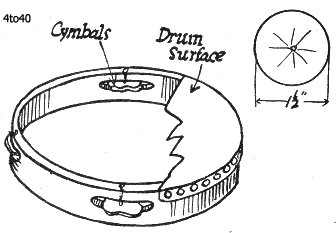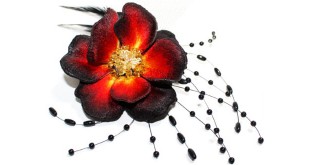 The Tambourine – Whilst on the subject of drums it would be interesting to show how that attractive but rather noisy tambourine can be made. Get one of those cardboard cores that are inside rolls of linoleum and have this cut down to about 2 in. in depth.
The Tambourine – Whilst on the subject of drums it would be interesting to show how that attractive but rather noisy tambourine can be made. Get one of those cardboard cores that are inside rolls of linoleum and have this cut down to about 2 in. in depth.
Sandpaper the edges so that they are quite smooth and gently round these to give a finish to the drum. The actual diameter of the tambourine will depend on the size to suit you, 9 in. is an average for this type of instrument.
Now cut out four slots in this rim, as illustrated, measuring about 2 in. long and ½ in. deep. This can be done with a fret-saw. These slots are to take the cymbals. The cymbals are quite small and can be made from pieces of tin, cut round to about I ½ in. in diameter and bent as shown, with a hole pierced through the centre.
A pair of these should be inserted in each slot, facing as shown, with a pin driven through the rim of the drum. Turn the end over of each pin at the top and bottom of the drum to secure. See that the holes in the cymbals are slightly larger than the the pins so that the cymbals are slightly larger than the pins so that the cymbals will move easily, and allow the discs to rattle and jingle with the movement of the tambourine.
The best way to cover the drum is to use very strong paper stretched over the surface and attached to the outside edges of the rim. Damp this paper and tack all round the edges of the rim and allow to dry so that the paper stretches to its full extent. When it is quite dry the paper will have shrunk and be a very tight fit to the rim and will now have a circular shape fitting the drum. Gum the inside edges of the circular paper and place in position on the rim and firmly secure round the outside edges with small brass headed nails.
When the drum surface is fixed and stretched to its maximum, give the outer surface a coating of linseed oil for added strength. It will also give the paper that interesting old parchment appearnce. Go over the outside edge of the frame with three coats of clear varnish and allow to dry thoroughly. You can paint a design all round this edge, using enamel paints to suit your own decorative ideas.
 Kids Portal For Parents India Kids Network
Kids Portal For Parents India Kids Network






